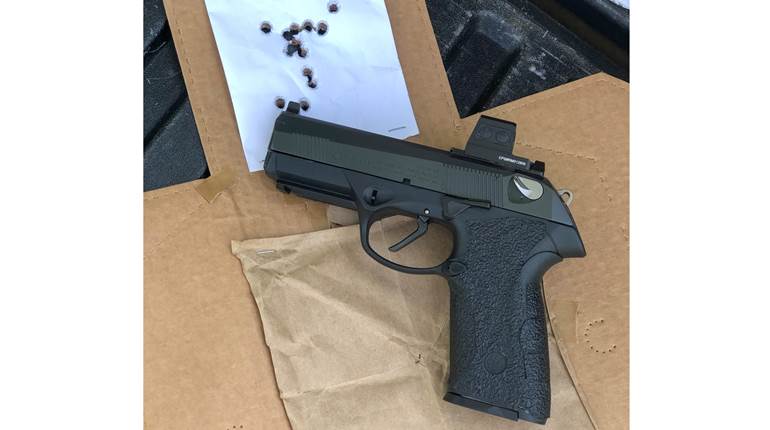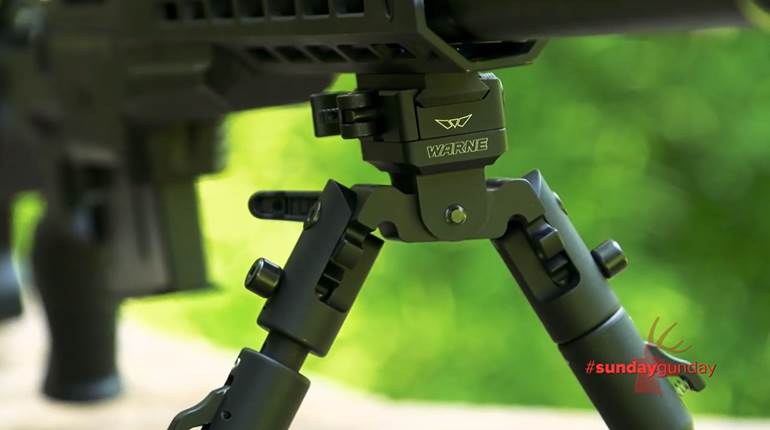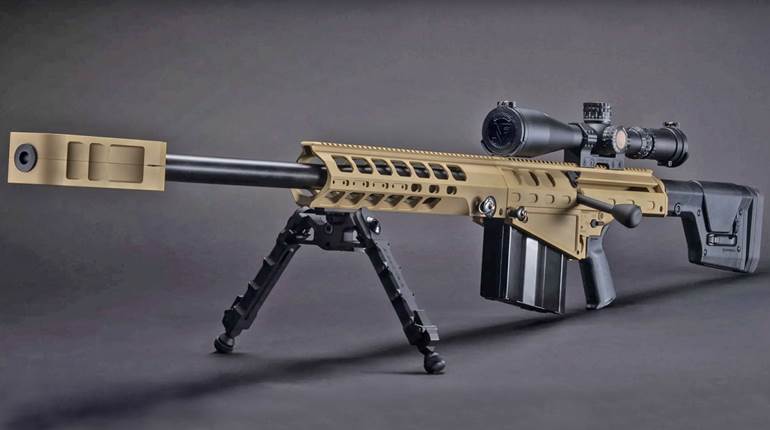
The name Fabryka Broni Łucznik (known to most U.S. shooters simply as “Radom,” after the town in which it is located) is likely familiar to fans of historical firearms. In case it is not, it is a highly respected armsmaker in Poland with a history dating back more than 90 years, and still existing today in a modern iteration. Beginning in the pre-World War II era, Radom earned a reputation for making high-quality firearms such as the wz.35 Vis pistol that combined solid design with top-tier manufacturing processes.
Unfortunately for Radom (as well as Poland as a whole), the nation fell under the sphere of Soviet influence after the end of World War II. This would have a profound effect upon Polish small-arms design and resulted in a distinctively Eastern-bent to its products. For obvious reasons, weapon systems such as Kalashnikov-based firearms became the backbone of Poland’s military small-arms community. As part of the new Soviet-centric system, Radom became identified as factory number 11 (symbolized by the classic “circle 11” logo seen on Radom-produced firearms from this era). 
In addition to AK-pattern rifles, Poland also initially followed the lead of Moscow in its military handguns procurement plans. The earliest example of this was the adoption of the Pistolet wojskowy wzor 1948, or “Military pistol, model of 1948,” manufactured by Radom. Based very closely on the Soviet TT-33 pistol in 7.62x25 mm, the plant made more than 200,000 samples of this rugged and simple pistol.
A New Future
Students of Cold War history will know that Poland became a very important part of the beginning of the end of the Soviet empire, with the Solidarity Movement symbolizing the resistance of the Polish people to control exerted by Moscow. What is interesting is that this growing independent streak also manifested itself in Polish military small-arms design as the Cold War era ground on.
A great example of this is when the country was looking to transition away from the Tokarev pistol-based handgun to a new, smaller handgun chambered in the new 9x18 mm round (introduced by Russia and chambered in its Makarov pistol). Rather than acquiring a license to produce its own copy of the Makarov, the Poles opted to instead develop their own homegrown version to be produced by Radom.
The result was the P-64 pistol, manufactured from 1966 to 1977. 
Featuring a double-action/single-action (DA/SA) trigger system, the P-64 was compact and reasonably powerful (the 9x18 mm cartridge is unique in that it is more powerful than the 9x17 mm .380 ACP, but can still employ a simple straight-blowback system of operation as opposed to the locked-breech system required by most 9x19 mm pistols). While the P-64 is comparable in size and capability to the Russian Makarov, it is a much closer sibling to the Walther PPK. The all-steel P-64 features a loaded-chamber indicator, quality machining, and nice polishing and finishing on the metal. The pistol holds six rounds in the magazine.
While the P-64 was a success, Radom determined it was prohibitively expensive to produce due to the extensive machining and polishing involved in its production. In response, in the 1970s Radom started to develop a replacement 9x18 mm design that would serve the same role but be cheaper and easier to manufacture. The result was the Wanad pistol, dubbed the “9 mm pistolet wz.1983” (or simply “P-83”) and adopted in 1984.
A Modern Take
If placed side-by-side with a P-64, the P-83 and its older sibling look similar in design at first blush. But closer examination reveals an important distinction. While the P-64 required time-consuming machining and finishing processes, the P-83 instead made extensive use of sheet metal and spot welding in its construction. Another area of notable difference is in magazine capacity; while the P64 has a 6+1 capacity, the P-83 has an eight-round magazine. The P-83’s magazine has open windows on both sides of the body to allow visual access to the number of rounds on board. 
The P-83 features a DA/SA trigger system and simple straight-blowback operating system like the P-64. With this system, a combination of spring pressure and slide mass keeps the action closed long enough for the chamber pressure to drop to safe levels before the action opens and the pistol cycles. The chrome-lined barrel of the pistol is pressed and pinned into the frame, and the recoil spring wraps around the barrel. 
Located just behind the somewhat small ejection port of the P-83 is a large external extractor. The trigger of the P-83 is also constructed from sheet steel and features tactile grooves for added purchase. The pistol’s external hammer has a deeply grooved spur that allows the P-83 to be thumb-cocked for single-action fire. A “hammer-drop” manual safety is located on the rear left side of the slide and features two positions. When in the “down” position, a red dot is exposed and the pistol can be fired. When the safety is swept up, it locks the pistol and prevents it from firing. If the hammer is cocked when this is done, the hammer is safely dropped and the pistol will not fire. In this case, the trigger will remain locked in the rearward position. To release the trigger, disengage the safety and it will snap back into the forward position. 
The magazine release of the P-83 (like that of the P-64) is a European-style “heel” release located at the rear base area of the grip. It is a grooved tab that sits in a recessed portion between the lower rear halves of the wraparound synthetic grip panels. Located on the bottom edge of the left grip panel is an integral lanyard ring. 
From an operational/handling standpoint, one point where the P-83 differs significantly from the P-64 is in its inclusion of a slide catch/release lever. The stamped steel part is located at the top of the left-hand grip panel and is pushed up by the follower of the magazine when empty to lock the slide open. The P-64 would lock open on an empty magazine, but did not have an external release. You would simply insert a fresh magazine and retract and then release the slide on it.
As is common with Eastern European pistols from this era, the sights on the P-83 are quite rudimentary. The front sight is a blade unit integral to the slide while the rear sight is a drift-adjustable notch unit. Serrations along the top of the slide are designed to diffuse sunlight glare, and simple vertical slide serrations are located at the rear of the slide. A loaded chamber indicator is located on the left, rear side of the slide, below the rear sight and above the manual safety. 
Disassembly of the P-83 is pretty simple and straightforward. First engage the safety, remove the magazine and ensure the chamber is not loaded. With the action closed, pull straight down on the takedown release that is located inside the forward, upper face of the triggerguard. Next, pull the slide fully to the rear and lift its rear portion up and off the slide rails. You next ease the slide forward at an angle until it clears the barrel. You can now remove the recoil spring.
One of Your Own?
After the collapse of the Soviet Union in the early 1990s, firearms such as the P-83 that would have previously been rare and difficult to find are now available and often quite affordable. In fact, good numbers of P-64 and P-83 pistols are on the market today. I recently picked up an excellent condition P-83 with matching numbers for myself from Southern Ohio Gun.
The pistol was described as being in “very good” to “excellent” condition, and I can find no fault with that description. The pistol features an excellent finish with practically no wear marks and excellent condition grip panels. In addition, it came with a spare magazine. As was my experience with a P-64 pistol I recently acquired, the DA trigger pull was extremely heavy (off the scales of my 10-pound trigger-pull gauge). The SA pull of the pistol was a manageable 5 pounds.
I have always had a weak spot for ComBloc firearms, and the P-83 is no exception. For a very reasonable price you can own your own sample of a very interesting Cold War-era pistol. As with all surplus guns, get them before they are all gone. For more information, visit southernohiogun.com.
Specifications
Caliber: 9x18 mm
Barrel: 3.5”
Overall Length: 6.5”
Weight: 26 ozs.
Grips: Synthetic
Sights: Blade front, notch rear
Action: DA/SA
Finish: Blued
Capacity: 8+1





































